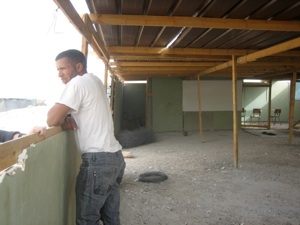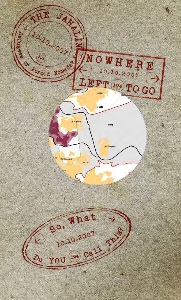Bedouin





The Bedouin are in a desperate situation (though I did meet one who, denying at least to me that anything was wrong, was selling Bedouin jewellery in the souk in Jerusalem). They are in a peculiarly problematic position in that they are a nomadic people, so it is easy for them to be caught under the Fallow Land Regulations (Water, Roads and the Land), it being claimed that they have ‘deserted’ their villages, or held that new camps are illegal. It is highly offensive to these people to be forced to live in one place: one of their most important principles is freedom. Bedouin are ecologically adept: they will go where it is cool and they have water in summer, where it is warm and not windy in winter. Further it is not permitted to be keepers of flocks, which was previously their livelihood.
Bedouin are being forced to live on about 2% of their former land. We met a group from the Jahalin tribe in the Judean desert. Three thousand from this tribe have been given eviction orders with nowhere to go; people who are no threat whatsoever to Israel. They do have tribal deeds for their land, which were recognized in turn by the Ottomans, the British and the Jordanian administration of 1948-67, and there are lawyers working on this. The Bedouin we met told us that the tribe had been in the Negev at the time of the Nakba of 1948.(History & Background) Then in March/April 1950 the military had come three times, killed six people, burnt down 15 tents and taken 400 sheep. They had been growing crops. The whole tribe fled to Jordan. This group was now about to be surrounded by the wall and had been given an eviction order.
This group’s spokesperson commented that they have no clinic, no hospital and no one comes to check their children. If a child is ill, it will be illegal for them to enter Jerusalem. There are other problems too. The Israelis will bribe one man who wants a permit, which will be given if he agrees to be a collaborator. Thus no one trusts anyone else. They no longer keep many animals (quite apart from the prohibition) as it costs more to feed them than they would ever get back. Rather are they forced to take building work in the settlements to keep their families alive. But this is becoming more difficult as foreigners take the jobs which previously the Bedouin would have done. Often they cannot get permits to work. The Palestinian Authority has been very slow in taking up their problems.
Bedouin children frequently have no education. The group we visited are trying to set up their own school. They had been told by the PA that if they finished their building by August (2009) they would be given a (Bedouin) teacher. The PA has no money to build the school. By contrast some Bedouin are highly educated, having PhDs from foreign universities. They well understand that education is the only way out of their situation; it becomes an absolute priority. But it can be very discouraging. ‘What’s the point: you study for 6 years at the university and then there’s no work. You go abroad and use your degree; or stay here and become a labourer.’ Bedouin living in the Negev (and thus Israeli citizens) have gone into the army to get work; they were often sent to serve in Gaza (thus forced to attack other Palestinians).
What impressed me was that the tent we saw - bar a TV and he had a laptop (!) - was almost completely bare. The camp, and school, are built illegally. The group is not allowed to bring electricity to their camps (whereas of course there is electricity going to all the settlers in the vicinity). They don’t even have sewage pipes. The indigenous people of course understood how to live in the desert. But now the settlers are taking the land – to grow vegetables which are sold in Europe. Two kilometers from the camp that we saw there is a large coke factory, in the desert, depriving the people who live there of much needed water. Palestinians can no longer reach East Jerusalem to sell their produce in the markets there.
The camp we visited is surrounded by settlements and the situation dangerous. If you go onto settler land, settlers may beat you up and ring the police. Over the age of 16, on the first offence you will have to sign saying that you commit to paying 5,000 shekels if you do it again. If a child runs onto the land, the child is taken to the police, where the parent has to collect the child and sign that the child will not cross onto that land again (if children do, presumably the parent has to pay). The land on which the Bedouin set up camp may be used by the army as a firing range. Tanks can fire from 6 km away; they are out of sight and a man who is a shepherd doesn’t know they are there. One man lost a leg, his stomach, 3 fingers and an eye from a gun. The uncle of the man who told this story had been killed by a tank: like in Gaza, he commented, it cut him into tiny pieces.

Bedouin
The Camp
We visit the Bedouin in their tent
The school in progress


Dangerous ground:
the hill which rises opposite is settler territory.
A Bedouin and a radical Israeli converse on equal terms.

Specialist Literature:
- Nowhere Left to Go, ed. Angela Godfrey-Goldstein, ICAHD, 2007. Downloadable at http://icahd.org/eng/publications.asp.
- The Arab-Bedouin of the Naqab-Negev Desert, UN Committee on the Elimination of Racial Discrimination, May 2006.
-
-Reem Mazzawi, ‘Displacement of the Jahalin Bedouin’, al majdal, double issue no. 39/40 (Autumn 2008/Winter 2009), BADIL Resource Center for Palestinian Residency and Refugee Rights.
-
-http://www.guardian.co.uk/commentisfree/2009/dec/03/israel-negev?
-
-‘Israel’s Negev “Frontier”’, ‘Bedouin Women Rise Up’, Palestine News (PSC magazine), summer/autumn 2010, respectively.
At the time of the November 1947 General Assembly Resolution partitioning Palestine, the population of the Negev (Arabic Naqib) comprised 100,000 Palestinian Bedouin and 1,000 recent Zionist ‘settlers’. The effect of the GA Resolution was to confer citizenship on the ‘settlers’, while rendering the Palestinians stateless.
(The Guardian, 03.12.2009)
‘On Tuesday 10 August 2010 at 6:00am sixty Israeli Police accompanied by Israel Lands Administration (ILA) representatives commenced the third demolition within 2 weeks of Al-Araqib, a Bedouin village in the Negev Desert. The village is located between the cities of Rahat and Beersheba, and is home to some 300 Bedouin citizens of Israel.
Demolition forces arrived with two bulldozers, a dump truck, tow-truck, and 40 police cars to aid in the one and half hour operation that razed at least 10 make-shift homes, all rebuilt following the previous demolitions suffered by the community. Other agricultural structures were demolished and property was confiscated, including building materials and a large water tank. The only paved road into the village was also destroyed. Government officials insist that the demolitions are in conformity with Israeli law, however court cases are currently underway regarding ownership of the village lands.
During the course of the demolitions, an Israeli activist and a Bedouin from the community were arrested. The Israeli activist refused a conditional two weeks ban from the village and will be arraigned in court today. Approximately 40 Israeli and international activists were present during the demolition in support of the community.’ (ICAHD website, August 2010)

Ma’an
Israeli bulldozer demolishing sheds and sheep pens belonging to a group of Bedouins living in Abu Al-Ajaj, a village in the Jordan Valley, Nov. 2010.
Present Problems
The Jewish National Fund and Jewish Agency are attempting to boost the settler population of the Negev and to drive out the Bedouin. In response to their dire plight the Bedouin, for their part, are becoming increasingly politically active. In July/August 2010 the authorities raised to the ground Al Araquib, one of 45 so-called ‘unrecognised’ Bedouin villages (which a planning law of 1965 had simply left off the map). This action has galvanised resistance. On Land Day 2010, 3,000 Bedouins gathered at al-Araquib to protest. Further, in August 2010, 700 Bedouin women travelled from the Negev to Jerusalem to demonstrate against the ethnic cleansing and the demolition of their homes. Further demolition is taking place in the Jordan valley. MAP has at present an emergency appeal for funds to keep open a mobile clinic which serves Bedouin health needs there. In the UK a conference was held at Exeter University in Feb. 2010 attempting to think through and help with the situation.
On 2 June 2011 Ha’aretz reported that the Israeli government has plans to relocate 30,000 Bedouin living in ‘unrecognised’ settlements in the Negev.
See Further on this Site: